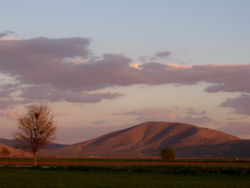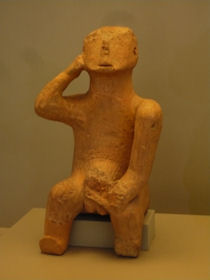O ur headquarters are located in the village of Ilias,in the municipality of Fyllo and the Karditsa Province, while our estate is situated in the "Arapas" location, near the village of Ampelonas, in the same municipality. Ilias is located on the Western border of the Province, between Karditsa and Larisa (approximately 25 km).
Geographically, we are situated in the Thessaly Plain, in the center of Greece, making the access to and transport of our bees feasible, in both distant, landlocked areas (Kalamata, Arcadia, mountainous regions of Epirus, Macedonia and Thrace) as well as on islands close to the mainland (Thassos, Skopelos, Euboia).
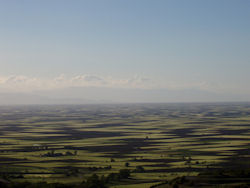
The Thessalian plain as it appears from the hills at its Southwestern border.
The surrounding area is basically all lowlands, with the exception of a group of hills and low mountains (Mount Fyllion) to the East and to the South.
We chose to continue the traditional methods in this fertile area by following in the steps of its first inhabitants.
History
The well known myth of Deucalion and Pyrrha makes reference to Thessalian land. Current data indicate that the region has been inhabited since prehistoric times (the most ancient Neolithic period until the Bronze Age), when the Pelasgians took advantage of the abundant food sources provided by the fertile land. Archeological excavations in Thessaly (both random and planned) uncovered a wealth of material, with regards to both the number of finds (approximately 600 statues, not including tools - in 32 "Neolithic sites" until 1973) as well as to the quality with regards to the information gleaned regarding their classification.
"The Thinker" is the first exhibit piece that visitors come across when visiting the National Archeological Museum. The Museum˘s reference (to the exact copy) reads as follows:
5894 "The Thinker". Large, solid figurine of a sitting man from the Karditsa, Thessaly region. Final Neolithic Period (4500-3300 B.C.). To date, the largest and only piece from the Neolithic period which has elements found in less stylized sculptures of later periods. The piece is crudely molded regarding detail. The individual elements make up the form of a robust man gazing upward, with a male build in a moment of action. The pronounced phallic element, the main portion of which has been broken, in combination with the size of the figurine, imply the religious character of the work. It may represent the agricultural deity associated with the fruit-bearing earth.
The productivity of the Thessaly Plain is renowned since ancient times and has led many peoples (and Greek tribes) to covet the area, leading to conflicts (Persians, Macedonians, Romans, Goths, Slavs, Ottomans) in many periods in history. For example, there are references to Mardonius’ “wintering” with his army in Thessaly before his final effort to defeat the Athenians, as well as to Karaiskakis’ attempt to block supplies to Kioutahis from the Thessaly Plain. The Plain was also exploited by Greek landowners, ultimately leading to the Kileler Rebellion and reparations to the peasants.
The "Prehistoric Sykeon Settlement " as well as "Sykeon˘s Tomb" are located 1 km north of the village, and provided rich archeological material. Roman baths with impressive mosaic flooring are located to the north of the settlement.
At the "Gioli" site, to the northeast of the village, the prehistoric "Fyllos" settlement, with the Fyllion Apollon" Sanctuary, are considered to have been located, although the time of the settlement˘s founding is unknown.
One of the numerous "Magoules" of the Thessalian Plain is also located at the edge of the village, however its excavation is not currently planned.
An Orthodox church, dedicated to the Prophet Elijah and located in the village˘s central square was built in 1858, and represents the domeless three-level Basilic style, with a "gynaikonitis" (women˘s section) and an internal well.
On a clear day, all the mountain peaks surrounding Thessaly (Olympus, Kissavos, Orthis, Agrafa, Koziakas-Pindos, Hasia) are visible.
The name of the village is interesting, obviously coming from the Prophet Elija, even though this name is commonly given to mountain villages. The village could be the glebe land of a mountain monastery, by interpreting the fact that during the Ottoman domination, the name of the village did not change, unlike those of other villages. In more recent public archives, the name appears as Ilias, with an accent on the "i", not on the "a", which is accepted by those living there as a bureaucratic mistake.
The main occupations of the villagers were, and are today, animal husbandry and farming, even though the population has dropped from 450 (oral history) to about 65 (25 families). Adobe bricks, made from mud and straw which were then sun-baked were used for home building up to the period between the two World Wars, as a standard practice of all cultures to use those materials found in local abundance.
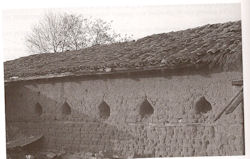
Adobe walls instead of beehives.
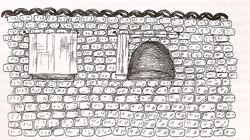
"Poulitsa" with curtain, so as to close the entrance during the winter months.
Drawing by Sofia Daispyrou, with strict instructions and approval
from Mrs. Paraskevi Dinopoulou.
In these houses, "poulitses", or small entrances between the walls, were constructed for bees. Thus, the bees were considered domesticated animals, and were generally one of the major responsibilities of the women whose families had beehives.

Traditional House
